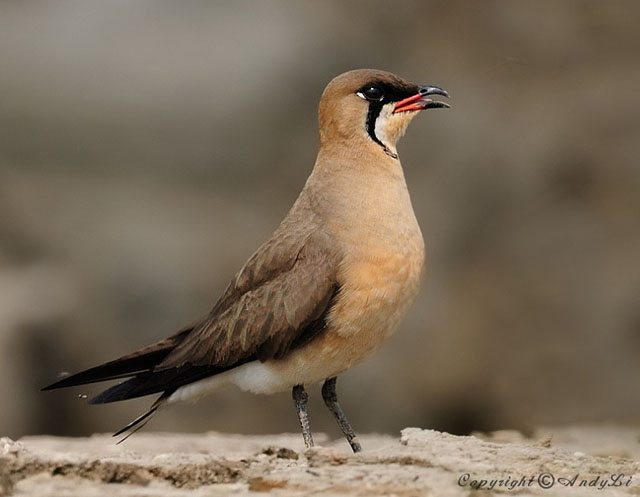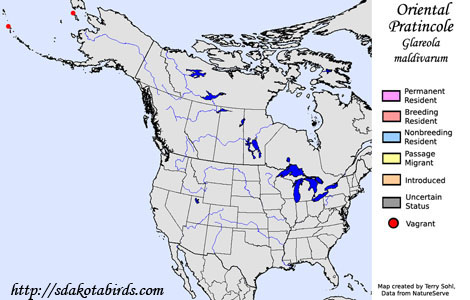| Length: 9.5 inches | Wingspan: 18 inches | Seasonality: Non-resident in South Dakota |
| ID Keys: Olive-brown overall, long pointed wings, lighter cream/buffy color below, short black bill with red base, black stripe below eye that outlines the chin | ||
 The
Oriental Pratincole is a shorebird of the Old World. Their breeding
range extends from Pakistan in the west, eastward through China, and into
much of southeast Asia. Most Oriental Pratincoles overwinter in
Australia, where they can sometimes be seen in flocks that number over a
million individuals. In North America, they are just extremely rare
vagrants, with a handful of sightings in the Aleutians and Alaskan islands
of the Bering Sea.
The
Oriental Pratincole is a shorebird of the Old World. Their breeding
range extends from Pakistan in the west, eastward through China, and into
much of southeast Asia. Most Oriental Pratincoles overwinter in
Australia, where they can sometimes be seen in flocks that number over a
million individuals. In North America, they are just extremely rare
vagrants, with a handful of sightings in the Aleutians and Alaskan islands
of the Bering Sea.
Habitat: Found on flood plains and sparse grasslands and steppes during the non-breeding season. Breeding birds are found in similar open habitats, including around wetlands and lake and river shores.
Diet: Feeds on insects, spiders, and other small invertebrates.
Behavior: Unusual foraging technique for a "shorebird", in that most insect prey are caught while in flight. They will also sometimes foraging by walking along the ground. They are a very gregarious species, often occurring in very large flocks.
Nesting: In their native Asian range, the Oriental Pratincole is a colonial nester, often mixed with other species, particularly Old World tern species. The nest is a simple depression on the ground. The female lays 2 or three eggs, with both parents caring for the young when the eggs hatch.
Song: The most common call is a "kyik"
Migration: Breeds in much of the southern half of Asia. Strongly migratory, with most birds wintering in Australia, and much smaller numbers possibly overwintering in New Guinea or New Zealand.
Interactive eBird Map: Click here to access an interactive eBird map of Oriental Pratincole sightings
Similar Species: Not likely to be confused with other species that have been seen in North America. They are similar to the Australian Pratincole or the Collared Pratincole, species not seen in the New World.
Conservation Status: Populations appear to be decreasing. However, global populations still number in the millions, they are common in parts of their range, and they are found over a wide geographic area. The IUCN lists the Oriental Pratincole as a species of "Least Concern".
Further Information: 1) Australian Government - Department of Sustainability, Environment, Water, Population, and Communities - Oriental Pratincole
2) BirdLife International - Oriental Pratincole
3) Queensland Wader Study Group - Oriental Pratincole
Photo Information: Photo taken by Andy Li - Photo licensed under Creative Commons Attribution NoDerivs 2.0 Generic License.
| Click below for a higher-resolution map |
 |
| South Dakota Status: Non-resident in South Dakota |
Additional Oriental Pratincole Photos (coming soon!!)
